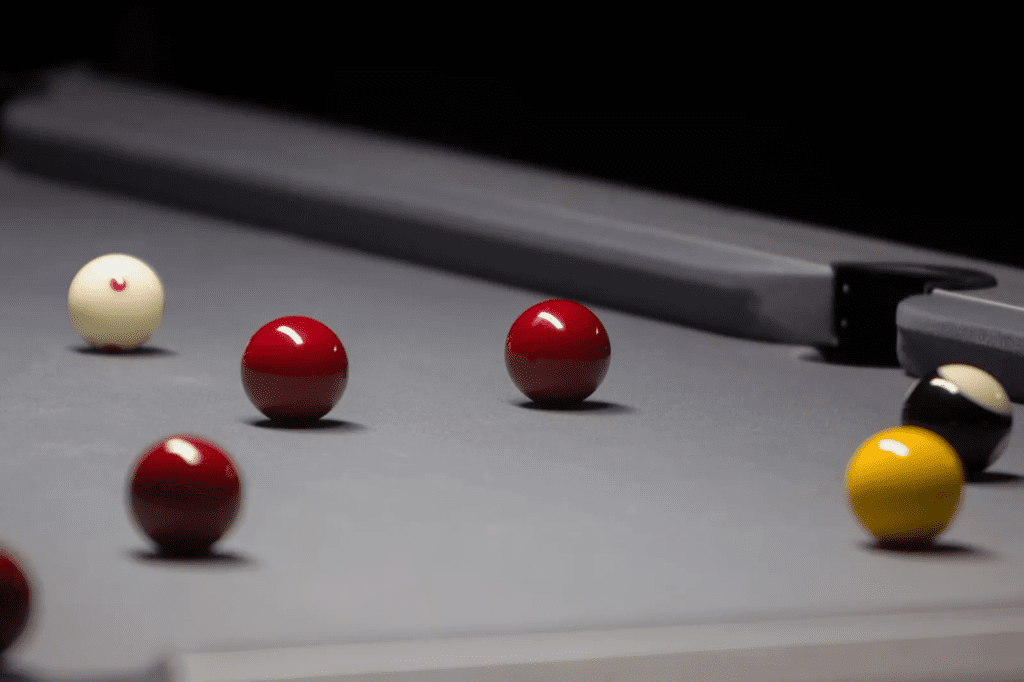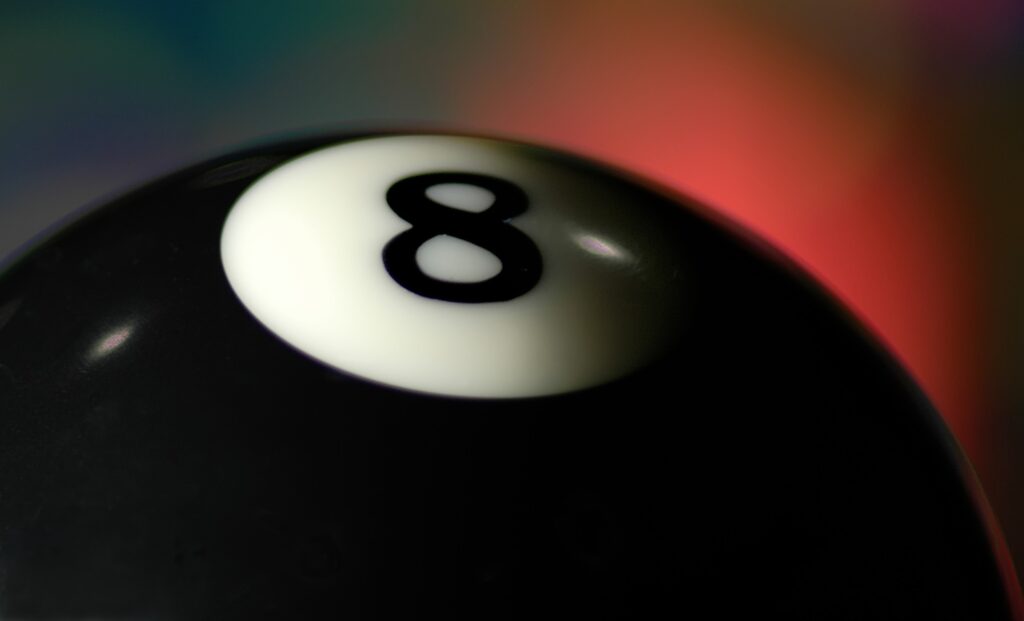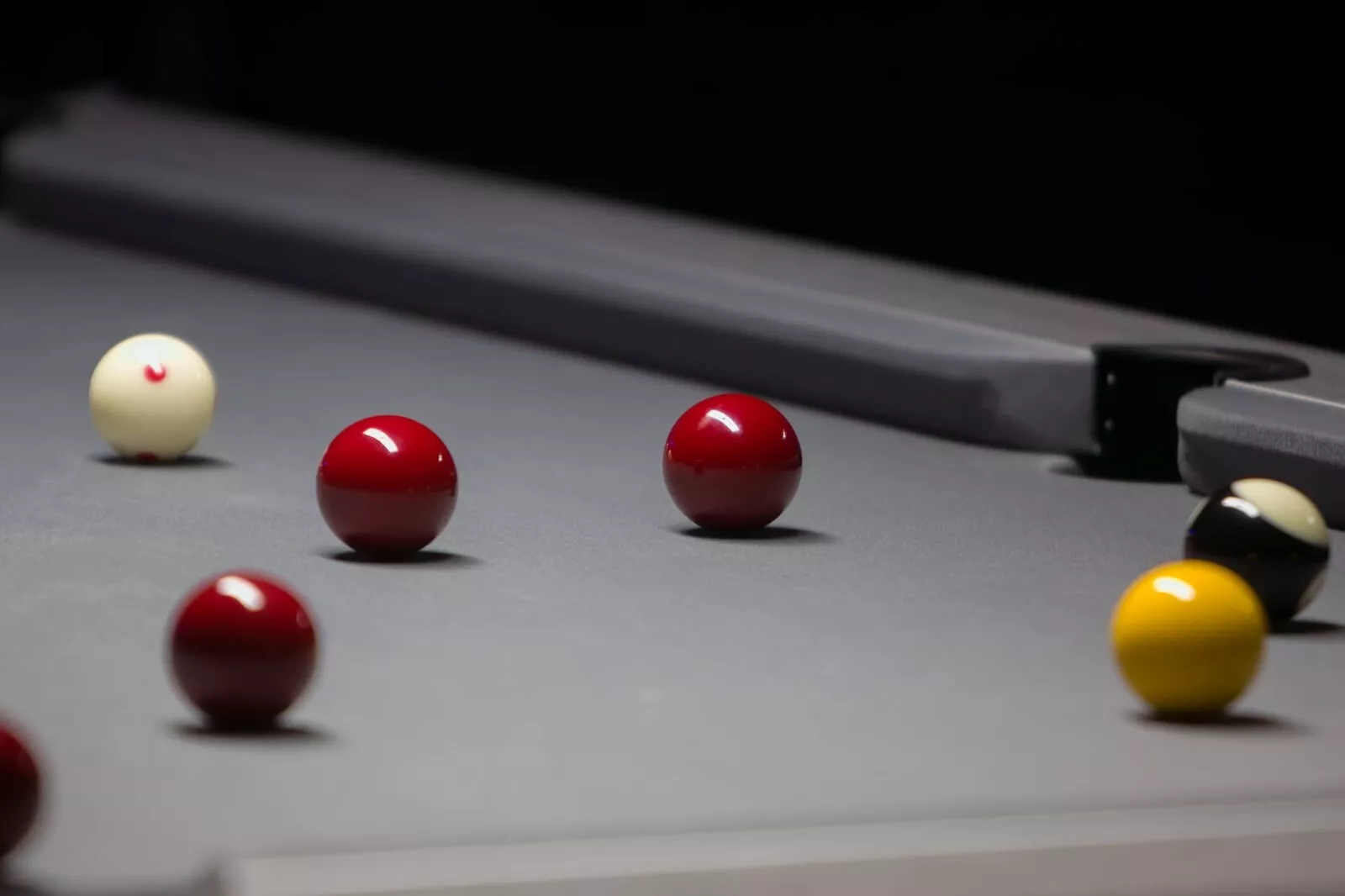Welcome to Spots and Stripes in Redhill, Surrey! Whether you’re a seasoned player or a newcomer eager to dive into the world of English 8-ball pool, understanding the official rules is key to enjoying the game and playing it right. This blog will walk you through the comprehensive international Pool rules of English 8-ball pool.
Let’s get started.

1. The Game and Its Objective
English 8-ball pool is played with a cue ball and 15 object balls, consisting of 7 red balls, 7 yellow balls, and 1 black ball (the 8-ball). The primary objective is to pot all balls of your group (either reds or yellows) and then legally pot the black ball to win the game. The game is played on a rectangular table with six pockets.
2. Starting the Game: The Break
The game begins with a break shot, where the balls are racked in a triangular shape with the black ball in the center. The player who wins the lag or coin toss chooses whether to break. For a break to be legal:
Lagging Procedure
- Balls shall be of equal size and weight
- To start the lag the referee will count the players in by counting back from 3 to 1 (If a referee is present).
- The players shall simultaneously strike balls (on the referee’s indication – if the referee is present) towards the top cushion.
It is an automatic loss of lag if a ball:
- Crosses into the opponent’s half of the playing surface OR
- Fails to contact the top cushion or
- Drops into a pocket or
- Hits a side cushion or
- Jumps off the table or
- Comes to rest on the playing surface within the area of the corner pocket or
- The player commits any standard foul.
Players will lag again if:
- Both players foul or
- The referee is unable to decide on which ball is closest to the bottom cushion or
- One player’s ball strikes the top cushion before the other player’s ball is hit.
- To commence a frame, the player who is breaking shall position the cue ball anywhere in baulk but MUST NOT position the cue ball over the break line by more than 50% of its diameter.
The Break will be deemed a ‘Legal Break’ if the player breaking, obtains a minimum of three cumulative points.
- 1 point for each object ball potted (eight-ball included, so thus does count).
- 1 point for each object ball that has passed an imaginary line between the two centre pockets, that is not potted. A ball is deemed as having ‘passed’ the centre line if the whole ball is over the imaginary line.
Failure to perform a legal break MUST result in a re-rack. The opponent has the option to break or to choose to give the break back to the original breaker.
Groups are not decided on the break. The table remains open after the break. If the player in control of the table does not make a legal pot, the table is still deemed open for the incoming player.
If the eight-ball is potted off the break, it is always re-spotted after all balls have come to rest on the table. To re-spot the eight-ball, the centre point of the eight-ball is placed on the eight-ball spot or if this is not available as near as possible to the spot in a direct line between the spot and the centre of the top cushion.
If there is no space available on this line, place the eight-ball as near as possible to its spot in a direct line between the spot and the bottom cushion.
If the eight-ball is the ‘only ball potted on a legal break’ then control of the table goes to the incoming player. If it’s potted with other groups and the criteria of a legal break has been fulfilled, the breaker continues.
If the cue ball is on a legal break:
- Goes “in-off”, a loss of turn occurs and the incoming player is awarded one visit with cue ball in hand, to be played from baulk, in any direction.
- Leaves the playing surface, a standard foul will be called against the breaker, with the incoming player receiving one visit, played from anywhere on the playing surface.
3. Determining Groups: Reds or Yellows
After a legal break, if a player pots a red or yellow ball, they continue with that color for the rest of the game. If a ball of both groups is potted, the table remains open, meaning the player can choose either group by potting a ball of that group on their next shot. Once groups are determined, the players must aim to pot all balls of their group.
4. Legal Shots and Safety Play
Each shot must result in the cue ball striking a ball of the player’s group first. A shot is legal if:
– A ball of the player’s group is potted.
– The cue ball or any object ball makes contact with a cushion after the cue ball hits the intended ball.
Safety play (or defensive play) is allowed, where a player may deliberately avoid potting a ball to position the cue ball advantageously or disrupt the opponent’s strategy.

5. Fouls and Their Consequences
Fouls can dramatically affect the course of the game.
As long as the player strikes an ‘on’ ball first, should an opponent’s ball be potted without also potting an ‘on’ ball, it will be a loss of turn. Control of the table returns to the opponent; the cue ball is played from where it lies.
The only exception to this is during an open table where the choice of groups has yet to be decided.
- Potting an opponent’s ball accidentally.
- Failing to complete a legal combination shot.
- A tactical shot e.g. playing a designated group legally to pot an opponent’s ball.
- Failure to call a group after potting a ball, whilst the table is ‘open’, if the group was not obvious.
Potting an opponent’s ball(s), without potting the ball ‘on’, having hit the ball ‘on’ first, will result in a loss of turn. The opponent plays the cue ball from where it lies. Examples of this are an unsuccessful combination shot or playing a tactical/turnover shot.
If on an ‘open’ table, a player makes an obvious attempt (no need to nominate) to hit a specific group and misses it completely (no contact) and proceeds to pot the opposite group, the referee shall call ‘loss of turn’ and the table remains ‘open’.
If on an ‘open’ table, a player strikes the cue ball and makes initial contact with one group and the shot progresses into potting the opposite group only, the referee shall call it ‘loss of turn’ and the table remains ‘open’.
If on an ‘open’ table, the group the player intends to play is not obvious, a nomination of a group is required. For example, this could be that the player is playing towards a cluster of balls or a ball(s) of each group that are near each other or fails to nominate a group on an ‘open’ table when a touching ball has been confirmed. After the shot is played, the referee shall call it ‘loss of turn’ and the table remains ‘open’.
If on an ‘open’ table, no referee present, a player calls one group, but intentionally plays the opposite group to try to force the loss of turn, the player will continue on the group potted. You cannot use the nomination rule to force a ‘loss of turn’.
6. The Black Ball: Winning and Losing the Game
The black ball, or 8-ball, can only be legally potted after all of a player’s group balls have been potted. The game is won by legally potting the black ball in a designated pocket. However, the game is lost if:
– The black ball is potted prematurely or in an unintended pocket.
– The black ball is potted on the same shot as the last of the player’s group balls, except during a legal skill shot.
– A foul is committed while potting the black ball.
7. Loss of frame fouls
Deliberately not playing a ball from their own group first, or an “on” ball after a foul. Prohibits deliberately striking your opponent’s ball first, this does not include accidents (miscues, miss of a fine cut).
- Unsporting behaviour / bringing the game into disrepute. Including but not exclusive to:
- A second offence for Foul language (A verbal warning is given for the first offence) OR
- Throwing a cue around / unscrewing as if to concede OR
- Continually arguing with the referee or opponent OR
- Interfering when the opponent is on the shot either verbally or physically.
Not playing in the spirit of the game (unsporting behaviour), for example (but not limited to):
- Audible bad language for a second time after being warned.
- Excessive hitting the table, physically or with a cue.
- Dismantling a cue or placing a cue in its case.
- Constant arguing with the referee (refusing to accept the referee/senior referee’s decision) or opponent.
- Gamesmanship – Attempting to interfere with the opponent’s shot, either verbally or physically. This could include jangling coins in their pocket, noisily chalking a cue, moving about in an opponent’s eye line or making audible comments.
- Repeatedly marking the table.
- A player making a deliberate attempt to stop the cue ball from going ‘in off’ by any means possible. Just because a player thinks something is about to happen (i.e. An ‘in-off’) they cannot assume it will as an outcome (i.e. The cue ball could jump back out of the pocket).
- Committing a foul in the same shot that the eight-ball is potted. (Except on the break)
- Potting the eight-ball when a ball or balls of the player’s own group are still on the table. (Except on the Break) Including potting the last group ball and eight-ball in the same shot.
- A player who clearly and intentionally fails to make an attempt to play a ball(s) of their own group.
- Prevents you from refusing to play a shot (this includes a deliberate time fail, but not any time foul – it must be deliberate) or playing a deliberate foul instead of making a legitimate attempt to escape a snooker.
- If you attempt a shot at the ball ‘on’ but leave the cue ball way short of the attempted ball ‘on’, the referee has the right to call it a deliberate act to leave the ball short, potentially so as not to disturb other balls near your ball ‘on’ to gain an advantage.
- If you are unable to come to a definitive conclusion regarding the shot to which you must rule upon, to determine a ‘loss of frame’, your course of action should be in the first instance to warn the player that you cannot be sure 100% that it was a poor enough attempt and if they play a similar shot again then you will call ‘loss of frame’.
- Potting the eight-ball legally, then proceed to move the remaining balls before they have come to rest.
- Deliberately striking the cue ball with any part of the cue other than the tip in general play. Positioning the cue ball with the cue is allowed as long as the tip of the cue is not used.
- Deliberately striking any ball other than the cue ball with any part of the cue or cue tip.
- Deliberately moving a ball(s) other than playing as part of a shot.
7. Special Situations and Skill Shots
Skill Shot – A player may pot an opponent’s ball along with their own ball in a single shot without it being considered a foul, provided the player’s ball is potted legally.
– Stalemate: If both players agree that the table is in a position where neither can win, they may declare a stalemate. The game is then restarted with the original breaker.
8. Etiquette and Professional Conduct
In both casual and tournament settings, players are expected to adhere to high standards of conduct.
This includes respecting opponents, avoiding unsportsmanlike behaviour, and playing fairly. Following the rules not only ensures a fun game but also upholds the integrity of the sport.
Ready to Play?
Now that you’re familiar with the international rules of English 8-ball pool, it’s time to put them into practice!
Whether you’re playing a friendly game at Spots and Stripes or preparing for a competitive match, knowing these rules will help you play with confidence and skill. So grab your cue, take your shot, and may the best player win!



